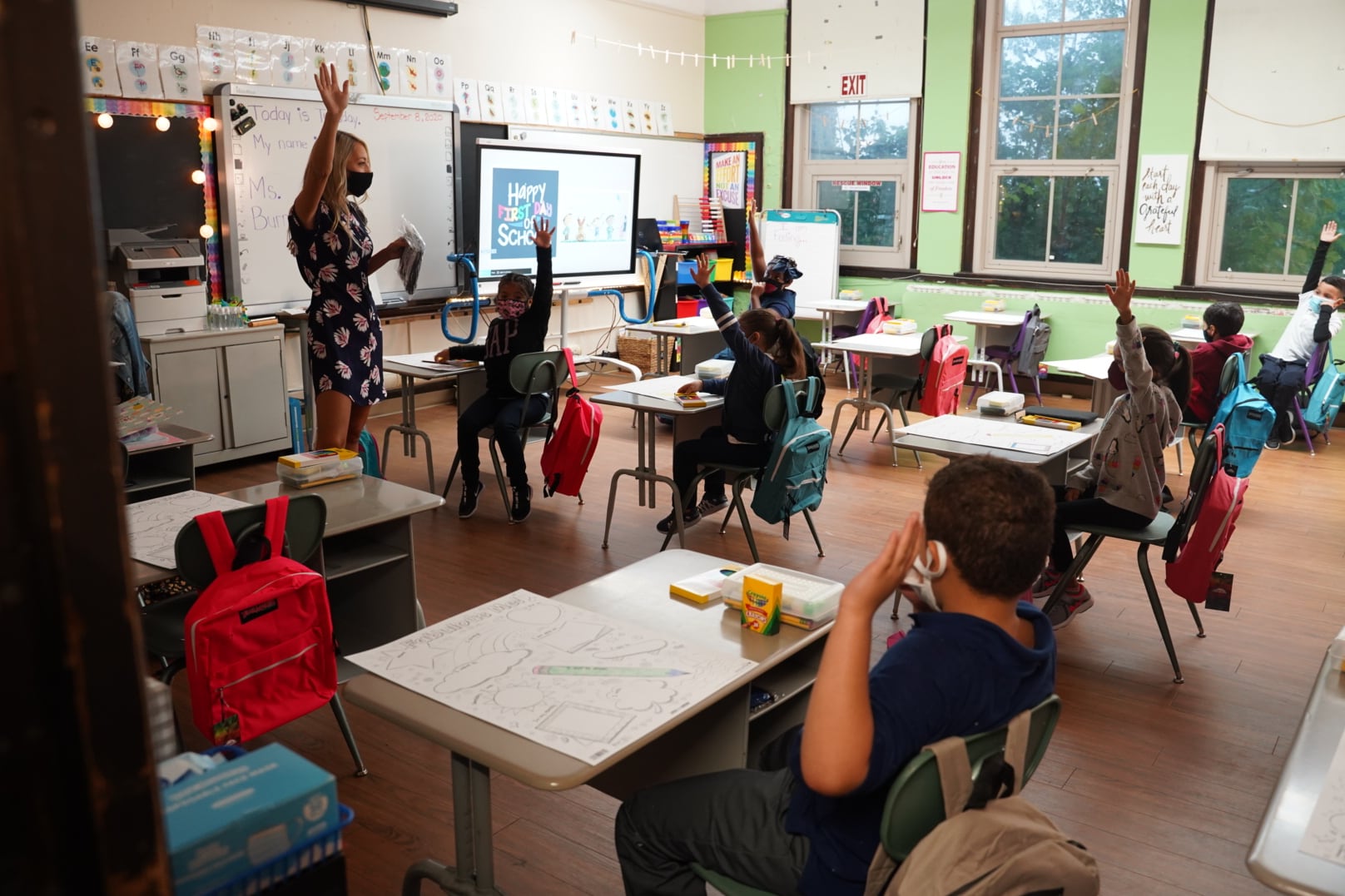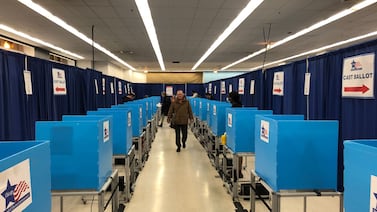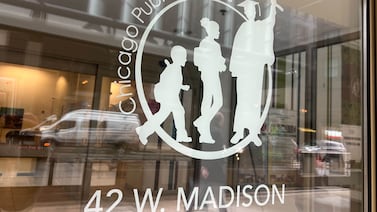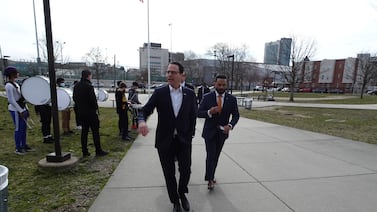Tyrise Carey couldn’t contain her excitement this past winter when the Detroit school district announced plans to reopen its learning centers, where students have gotten support from staff while the coronavirus has shut down regular in-person classes.
“Yes!” the eighth-grader told her mother, Sharene Nathan. “Call the bus. Tell them I’m ready.”
Seeing her daughter so pumped to go back into a school building — which she was able to do when the Detroit Public Schools Community District reopened learning centers in mid-March after a shutdown that began in November — made Nathan feel good that her daughter still has a passion for school.
“I don’t want that flame to go away,” said Nathan, a parent action leader at her daughter’s school, a position that requires her to work as a paid liaison between parents and the school.
As the Detroit school board prepares for a planned vote Tuesday on the fate of in-person learning for the rest of this school year, in-person learning advocates like Nathan have become increasingly vocal, countering a competing organized push to keep students remote.
The stakes are high. Loads of data, in Detroit and beyond, show students who are learning remotely are struggling. In Detroit, for instance, absenteeism is up. So are failure rates.
The debate over in-person versus virtual learning in Michigan has largely been dominated by suburban parents who have aggressively pushed their schools to fully reopen. These parents have protested at school board meetings and picketed outside schools. One Oakland County parent recently sued her school district, alleging district officials got her fired from a marketing job over her social media posts advocating for in-person learning.
Though two recent national polls found that most parents are receiving the kind of education they want for their children during the pandemic, debates have erupted across the country pitting parents wanting their kids in school buildings against those who want them at home.
In a Buffalo suburb, parents filed a lawsuit seeking to force their district to provide in-person instruction five days a week. The case reached the state supreme court. Randi Weingarten, president of the American Federation of Teachers, last week called for fully reopening schools for instruction five days a week next fall. That’s despite resistance from some of her union’s local affiliates, including in Detroit where most teachers have opted to work online.
In Detroit the loudest voices since last summer have been those pushing for a complete shutdown of schools. The opposition to reopening, led by a faction of the Detroit teachers union, has pushed to close the learning centers, all face-to-face learning, and to allow all staff to complete their work remotely, regardless of whether some jobs can’t be performed outside the school building.
They have used strong language, accusing the administration of racist behavior in requiring some school employees to work in buildings. One told the board at a recent meeting that they were endangering “our babies.” The Detroit Federation of Teachers negotiated an agreement with the district last summer that gives teachers the option of teaching in-person or remotely.
The debate in the city district came to a head last month, when several board members voted to shut down in-person learning for the remainder of the school year. The 3-2 vote in favor of the shutdown failed, though, because two members were absent and board policy requires four votes for an action item to succeed. Two days later, the board voted to suspend face-to-face learning until Tuesday’s board meeting, while allowing the learning centers to reopen April 26.
Even though board members kept the learning centers open, Nathan is worried they’ll eventually shut them down through the end of the school year, as protestors have urged. She wants the board to know that closing learning centers would be a mistake. It’s a warning Brianana Link also wants to send to the board.
“Stop listening to the angry mob and listen to families and hear our voice,” said Link, whose son is a second grader at Gardner Elementary School. “Our voice is not being heard.”
‘Heartbreaking’ data shows pandemic effects
The pandemic has put school administrators and board members in unenviable positions. With every decision, they court dissension from one group or another.
The reality in Detroit is that many parents and school staff are still reluctant to return to school buildings. The city was a hot spot last year in the early months of the pandemic, and many lost relatives, friends, and other loved ones. As case rates began to surge again in March, prompting the district to suspend in-person learning for a second time this school year, concerns began to rise again. But positive case rates in the city and across the state have recently been declining. District leaders have touted not only the safety protocols it has established in schools, but also about $1 million in repairs to its ventilation systems to convince parents and teachers that buildings are safe.
Last summer, the district established a positive case rate of 5% in Detroit as its threshold for closing schools and switching to all virtual learning. Currently, the case rate is 10.5%. Superintendent Nikolai Vitti said recently that the district’s threshold for closing schools to in-person learning would need to be reconsidered, however, in part because of easy access to a vaccine for people 16 years and older. Since Vitti made that argument, the Pfizer vaccine has become available for children 12 to 15 years old.
There is growing evidence that online learning isn’t working for the majority of district students, something Vitti illustrated in data he presented to the board last month.
Data from the first semester in the district show the overall percentage of students who failed at least one course was 56%, up from 36% during the 2019-20 school year. That’s despite flexibility in grading Vitti announced earlier this year.
Broken down by quarter, and by mode of learning, the differences are stark. In the first quarter of this school year, 32% of face-to-face students failed at least one course, compared with 60% of virtual students. What’s even more interesting is what happened during the second quarter, when in-person learning was shut down in November because of increasing COVID-19 case rates. The failure rate for the second quarter rose to 46% for in person students, and 57% for virtual students.
The data, board member Sonya Mays said during that April board meeting, is “heartbreaking.”
“We’re now a year in and I have extreme concerns about the long term impact that the academic deficiencies are going to create for the students that we educate,” Mays said.
Other board members agreed. But some said they also had to weigh what they hear from staff concerned about a return to school.
“I still think we have a lot of work to ensure that we are … hearing from people in a meaningful way,” board member Sherry Gay-Dagnogo said last month.
Link doesn’t need statistics to know what happens when in-person instruction is suspended and her son has to learn virtually. She’s seen it happen in real time.
“At home, he’s not motivated because he’s in his comfort zone,” said Link, who works from home and also is a caregiver for her mother, whom she must visit daily.
She said her son, Johnny, should be in school because he has Asperger’s syndrome and needs the expertise of staff who are trained to work with him. He’d rather be learning at home, but she said that when he’s at school, “he doesn’t have a choice but to sit down and learn.” And, she said, he comes home with enthusiastic stories to tell about his school day.
Nathan sees a similar change in her daughter, who also has Asperger’s, a high functioning form of autism.
“Her connection with her resource teachers, with the other students is very important,” Nathan said. “It’s vital for her learning and for her social skills.” Nathan said that when her daughter was forced to learn at home, “she felt very isolated.”
In addition to being a parent liaison, Nathan has spent many days this school year working with other parents and school staff to canvass Detroit neighborhoods — knocking on doors and trying to connect with families. She said she’s troubled by what she sees on a regular basis.
For one, she said, there are parents who are struggling with virtual school and need their children in school buildings. Worse, she said, are the high school seniors who tell her they’re sitting out school and opting to work full time instead. The adults were told by some that instead of graduating from high school, they would get a GED, a high school equivalency diploma.
One young man told them he was working at an auto supply store. He’d already taken the GED.
“He showed us on his phone,” Nathan said. “He already passed it.”
Attendance, enrollment down
There are other major concerns. The district’s daily attendance rate is 75%, down from 85% during the 2019-20 school year. Chronic absenteeism — when students miss 18 or more days in a school year — is up. Nearly 64% of students are chronically absent, up from nearly 55% last school year.
And then there’s enrollment. After a couple of years of slight gains in enrollment, the pandemic caused a drop this year that could eventually hurt the district.
The state’s spring enrollment count, taken earlier this year, found the number of students in the district was down by more than 3,000. Michigan funds schools based on enrollment. So, in an ordinary year, that decline would cost the district about $25 million. But a combination of a temporary change to how schools are funded in Michigan and federal COVID-19 relief funding means the district won’t feel a hit this year and likely not next year.
Vitti also presented information at that meeting showing the Detroit school district was an anomaly among most metro Detroit schools that were providing in-person learning. He said it pained him one day to see the neighboring River Rouge district, which routinely recruits Detroit students, driving its buses into the city to pick up students.
“The challenging part when I see this is, from an equitable point of view, are we offering our children the same thing they would be offered in surrounding school districts. When the answer to that is no, that pains me,” Vitti said.
Nicole Conaway, a teacher in the district and a frequent district critic, told board members that same night that remaining closed is the right thing to do.
“How about we be the district that does the right thing?” she said.
‘Mixed feelings’ about returning
Unlike September and March, the previous two times the district re-opened its learning centers, Nathan’s daughter Tyrise wasn’t her usual enthusiastic self when it was time to return on April 26. She went back for that first day, and didn’t return for a week.
“She had mixed feelings,” Nathan said. “In her mind, she was like, ‘How long is it going to stay open this time.’ ‘’
This is what concerns her: That the frequent starts and stops are weighing on students.
Nathan hopes to convince school board members that whatever decision they make keeps parents like her in mind.
“A lot of parents don’t realize the magnitude and the power of their voice,” Nathan said.







